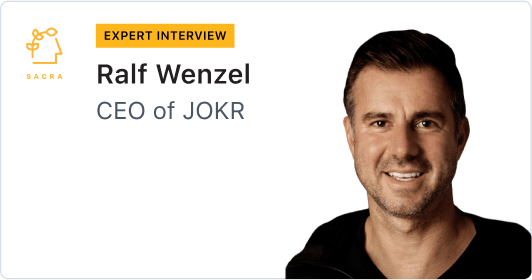
Background
Ralf Wenzel is the founder and CEO of JOKR. As part of our ongoing coverage of the ultrafast delivery space, we talked to Ralf about the aggressive geographic expansion of operators in the space, how JOKR is using data to optimize their SKUs and reduce costs, and what he thinks are the biggest misconceptions about ultrafast delivery.
Questions
- To start, could you talk about how the scope and scale of JOKR have expanded since its inception?
- How has customer engagement changed on the platform as the cohort matures?
- I'm curious to hear how data is helping with SKU optimization and feed recommendation to increase sales and inventory turnover. How long does it take for a region to mature for you to reap some of these benefits?
- JOKR has launched in nine countries. How do you think about the sequence in launching in new countries? Do you launch simultaneously in different countries with dramatic labor cost differences?
- How does the founding team decide whether to launch gradually to prove unit economics in one region or city or to scale quickly and massively to acquire as many customers as possible?
- How does scale effect emerge in your operation? What are the signs you look for?
- You mentioned that the media focuses too much on the 10% of online grocery platforms and the competition amongst them. What else do you think is the biggest misconception in the market about ultrafast delivery?
- How long does it take for one store to reach maturity?
- There’s criticism of on-demand groceries that the customer acquisition cost is high and the switching cost is low. What do you think this bearish view misses or misunderstands about your business that will drive its ultimate success?
- What's the core behavior or lifestyle that drives this more sustainable retention you just described?
- Capital allocation plays a big role in vertically integrated businesses. Is CAC one of the biggest investments at the moment? Could you talk about how you make capital allocation decisions?
- There are many operating levers in the business. For marketplaces, drops per trip is a very important metric, whereas for dark stores, increasing AOV can drive most of the operating leverage because the labor cost is fixed. Could you speak about the trends in AOV? How have your product categories have changed as a store matures?
- Is there anything important that we haven't touched on?
Interview
To start, could you talk about how the scope and scale of JOKR have expanded since its inception?
JOKR started at the beginning of this year, so we're not even twelve months old. We're having our eight-month anniversary this month. We started the company in Latin America, in countries like Mexico and Brazil. From there, we expanded further into Latin America and the United States. We also have some business activities in Europe. The main geographical focus of JOKR is the Americas, so the combination of the US and Latin America.
We see that in all markets -- not only in North and South America, but globally -- there's an opportunity to build more proficient, reliable, personalized, local brand-appreciating and sustainable online grocery companies. These are very strong secular trends. More and more customers are looking for efficient and reliable online solutions for grocery shopping. A big trend is that customers are shifting behavior from offline grocery shopping to online grocery shopping. Globally there are just not sufficient online grocery shopping options available. There are hundreds, or even thousands and tens of thousands, of offline grocery shopping options -- many different offline retail brands, many different supermarket brands -- but there are very few online companies. That's why the market is underserved. The market requires many more online companies to absorb the demand that is shifting from offline to online, especially among some of the younger demographics.
How has customer engagement changed on the platform as the cohort matures?
Overall, we see very strong customer engagement. Customers are coming back at least once per week, sometimes several times per week. We have very high customer engagement, a very high frequency of ordering by our customers, and also very high and stable retention rates. Our active customers keep on coming back. I think what is most important for customers is that you offer a reliable service so that when they're looking for a certain product or offering, the product gets delivered in the expected timeframe, at good quality, and by a friendly rider. It’s still most important to operationally execute well on an online grocery offering.
The second thing that customers are focused on and that motivates them to keep on coming back is the assortment. You need to be able to have a very comprehensive, high quantity grocery assortment, from packaged food to fresh food, snacks, drinks, and even alcoholic beverages. The assortment plays a very important role. Obviously, customers are also price sensitive. That's why you need to make sure that you're not offering products at a surcharge to what they would cost in the offline world and at the offline supermarkets. And lately, we have seen that customers care more and more about the degree of personalization. They want to be communicated in a very personalized and customized way, and they want to have a very proprietary user experience.
Customers care more and more about local brands as well, as opposed to the global CPG offerings. The more you can cater to the local product assortment, the more you can drive customer adoption.
Last but not least, this is a global trend that is not limited to grocery shopping, but more and more customers really care about sustainability. They want to understand what companies are doing to protect our planet. How do we build our processes and our product? How do we vertically integrate? Who do we work with? Which products do we sell that have a lower carbon footprint than a traditional supermarket?
All those components together are important to drive customer adoption. The more we articulate them, the more we can drive retention rates and the frequency of ordering by our customers.
I'm curious to hear how data is helping with SKU optimization and feed recommendation to increase sales and inventory turnover. How long does it take for a region to mature for you to reap some of these benefits?
The management, aggregation, and evaluation of data is key to everything that we're doing. The foundation of the JOKR business is a very proficient data science understanding and methodology, with a separate data science team that we've worked together with over the last few years in different business contexts.
What we are doing is aggregating very detailed data around our customer profile and demographics and aggregating data around the SKUs for the products that we are selling. What types of products are these? What types of ingredients do they have? How could they get classified?
We are also aggregating data around the geographies that we're in. The JOKR proposition is a hyperlocal one. We are building out the business neighborhood by neighborhood. Every single neighborhood is like a different country, so we collect information about the neighborhoods. What are the characteristics of the neighborhood? What other types of retail offerings are there? What is the demographic structure and so on? Then we contextualize these data points against the time of the day, like hour of the day, day of the week, week of the month, month of the year.
Based on that, we build patterns to understand what it is that customers want and when it is that they need it. The intersection of what and when is the key fundamental aspect of the JOKR proposition. And that is complemented by machine learning capabilities that we constantly evolve and aggregate and learn based on the ordering patterns of our customers. In a business that is high retention and high frequency, you are able to conclude on your data faster than in businesses that have a lower frequency. In an online furniture business where people buy a piece of furniture every three or six months, it takes a while to build these patterns. But in an online grocery context, you can do that faster.
Based on these patterns, we then decide: what do we need to procure, and when do we need to procure? What is the assortment that we need at what point in time? That drives the so-called category management and the inventory management that we are doing. Depending on the time of the day and the type of customer, we offer different types of assortments. If you log into our app in the morning, you will see a different assortment compared to logging into our app in the evening. If you and I both log into the app in the morning, we might see a different assortment as well, because we're tailoring the assortment to every single customer at any given point in time in any given geography.
That drives personalization as well as the higher sustainability of the model, because we care about what you really need. A normal retailer would stock up and have significant inventory losses because they procure in advance. The more data-driven you are -- which is the opportunity in an online context -- the more you can prevent inventory losses and really focus on relevance. Relevance drives personalization and adoption on the customer side; it drives profitability; it prevents inventory losses; and hence relevance also adds to the better sustainability profile of this business model.
JOKR has launched in nine countries. How do you think about the sequence in launching in new countries? Do you launch simultaneously in different countries with dramatic labor cost differences?
For us, it's not about countries. We never think about launching countries. We think about which are the attractive neighborhoods that we can launch into. The beauty of this business model -- and of most online models -- is that country borders do exist from a legal and administrative point of view, but they do not influence how we think about the business and where to roll it out. What drives our decision to launch in a new geography? It's the identification of attractive neighborhoods. If we find a neighborhood that is underserved in terms of online and/or offline grocery shopping, and if we think that we can capture an attractive relative market share on a per neighborhood business, that drives the decision of whether to launch a new market or not.
Given that we have a global platform with a global product, a global data science approach and a global team, we are agnostic as to whether we roll out our business in the US, South America, Europe or beyond. It becomes a question of management focus and of having teams available that can execute on it. But we're not making strategic decisions in terms of operating in one country versus another. We're making strategic decisions about entering a city with a certain number of attractive neighborhoods that we can go into. We had the opportunity and the luck to have great teams available from previous businesses that we built for Latin America, the US, and also Europe, and hence were able to execute on it, with our data science-driven acknowledgment of opportunities in any given city and neighborhoods driving that decision. That's how we will keep on doing it.
Launching a new city or a new country for us comes at less than proportional additional costs because we have very high operational leverage, given our global platform, data science approach, global engineering team, and playbook from an operational perspective on how to roll out in new cities, no matter where they are in the world.
How does the founding team decide whether to launch gradually to prove unit economics in one region or city or to scale quickly and massively to acquire as many customers as possible?
We as the founding team have been building businesses for up to 20 years. I would say that we have at least some level of experience in building businesses, and I think it always has to go hand in hand. We're not launching cities, neighborhoods or countries if we don't have a strong conviction around unit economics, and the unit economic evolution and progression in any of our geographies need to converge.
We always look into being able to capture a high relative market share, with market share measured by how many customers of the overall market -- which includes the offline market – we could capture. As you know, 90% of grocery shopping happens offline, and only 10% is online. In countries in Latin America and other emerging markets, the online share of grocery shopping is even lower than 10%. The press and the media always focus on the competition in that 10%, but we are all looking into getting a share of the remaining 90%. We are participating in the shift from offline to online. The media attention should rather be on that.
Making a long story short, we only get into neighborhoods where we have, in a data science-proven way, a realistic opportunity to be sufficiently gross profit positive to turn cash flow positive within a reasonable timeframe.
How does scale effect emerge in your operation? What are the signs you look for?
I think these types of online models -- at least it’s the case for our model -- grow very strongly organically. At this point in time, we have 20% to 25% weekly growth. It's an early-stage business, so it wouldn’t be surprising, but more than 50% of our growth is generated organically. Even if we switched off marketing today and didn’t do any marketing whatsoever, the business is still growing faster than most other traditional businesses and obviously growing faster than the entire offline retail industry.
If you build a great product, have a great customer experience, and have the right assortment, then you can be the company that can most leverage the organic shift from offline to online grocery shopping because that shift is happening anyway. People are looking for a more convenient, more time-saving, more personalized and faster way of grocery shopping, and if you are the service that has the best assortment and the most reliable service, and you have availability in the relevant neighborhoods, then you can participate most from that shift. That's what we're seeing, so we have only very moderate marketing in place at this point in time because 50% of our growth is organic from the 20% to 25% weekly growth. I would say it’s a luxury problem to have.
We are not worried about growth dynamics, especially not in the very underserved neighborhoods and cities of the US and Latin America, which lack great grocery shopping alternatives. We are really focusing on making sure we have the best assortment in place, the highest operational efficiency in place, and always provide on-time and in-full delivery. For more than 95% of our orders now, we're able to deliver within 15 minutes and in full -- containing all of the products that the customer has ordered -- with a very low rate of orders delivered above 15 minutes. We're very proud of the reliability of the service. That is the biggest growth factor, and that makes customers keep on coming back.
You mentioned that the media focuses too much on the 10% of online grocery platforms and the competition amongst them. What else do you think is the biggest misconception in the market about ultrafast delivery?
I think one of the misconceptions -- or maybe it’s a lack of appreciation -- is that people think in the online world everything is a winner-takes-all market. But especially a model like ours in the online grocery context -- a fully vertically integrated retail proposition, which needs to be built out neighborhood by neighborhood -- you have network effects on a per neighborhood level, yes, but overall it's not a winner-takes-all market.
If you go out on the streets of New York, how many retail brands do you see? There are endless retail brands, and most of them are surviving and coexisting next to each other. They all have a specific value proposition, a specific assortment, a certain brand language, a certain communication, a certain audience and so on. That's why we think that in the online context, there will be a handful of -- or even more -- successful players that can coexist next to each other. The pure dominance of Amazon in the online retail world is not proof of the winner-takes-all characteristic of the market. The dominance of Amazon is a sign and a proof purely that there do not exist many other companies that have an equally attractive value proposition to Amazon and its likes.
We think that there are too few online companies. Customers do not have the right choice. They have a very limited choice. Maybe they can choose in between one, two, three, four, five players. But if they go out on the street, they can choose between fifty or a hundred different brands. That's why I think overall there needs to be more online companies in total. All those companies will each have their distinct value proposition, assortment, branding, customer segmentation -- their uniqueness factor.
It's easy to build out your uniqueness factor if you're in control of your own supply, and only if there are a lot of online companies out there that are attractive for customers. Why do customers still go to the offline markets? It’s because there are not enough online markets or stores that they can shop from. Coming back to your question, I think it's not a winner-takes-all market. There will be many different successful players as customers shift their behavior from offline to online, and especially with the younger and upcoming demographics, this will accelerate even faster.
The second thing that is a misconception is that these types of business models will not be able to be profitable. Profitability is a function of operational efficiency. It's a function of scale because you need a certain number of minimum orders to be profitable. It's a function of time as well. If you build an offline supermarket, you need a certain number of customers coming into your supermarket every single day in order to turn profitable. An Albertsons, a Kroger, a Whole Foods, you name it -- if you only have ten customers per day, you will never pay your staff, your lease, your providers. It’s the same thing in the online world, and the online world is still under-penetrated and there are not enough options. We still need to educate customers. We're convincing customers to come from the offline world to us and hence we invest in marketing.
But overall, especially in the vertically integrated world in which we are running -- we're not running a marketplace but a fully vertically integrated retail proposition -- you have great control over different operational levers: you're in control of your delivery, of your marketing, of your supply. You influence when you want to turn profitable. It's not a random thing that you turn profitable or not. It's a conscious decision about when you want to be profitable, and you're always balanced between growth dynamics and profitability dynamics. There will be very profitable businesses.
I think businesses such as JOKR will be twice as profitable as the most profitable offline grocery stores. Offline retailers have an EBITDA margin that is in the lower single-digit figures. They can achieve between maybe 3% to 7% of EBITDA profit margin. Given the operational efficiency and the more data-driven approach that companies such as ourselves are running in the online context, we believe that we can, in the long term, have EBITDA margins that are twice as high as in the offline world.
How long does it take for one store to reach maturity?
It depends on the underlying operational structure, but in our model and the way we think about it, we aim to achieve profitability on a per-store basis within approximately 18 months of operations.
There’s criticism of on-demand groceries that the customer acquisition cost is high and the switching cost is low. What do you think this bearish view misses or misunderstands about your business that will drive its ultimate success?
In comparison to many other businesses, I think the benefit that we have is that we have stable retention rates. After a couple of months, you reach stable retention rates, and that's why, similar to the food delivery marketplaces such as DoorDash, Delivery Hero or Rappi, or a few others -- we were the team that was co-running Delivery Hero and built the foodpanda business in Asia -- you have almost an indefinite customer lifetime value.
Your active customers keep on coming back. You're always losing those that have tried out the platform and then decide to not get engaged because of all kinds of different reasons. But your active customers have a stable retention rate; they don't churn out. Having an indefinite customer lifetime value for your active customers allows you to engage more on the marketing side in a profitable way than for businesses that churn out 100% of their customer base after a few months. I've seen a lot of businesses on the offline side and on the online side where, after three, six or twelve months, you're churning out your entire customer base. But here you have a behavior that is similar to a subscription behavior, even though it’s not a subscription.
Again, coming back to some of the misconceptions in the market, as long as you have stable retention rates, you have dynamics that behave subscription-like, and you can count on a five or ten-year customer lifetime or even more, then you can make a conscious decision on your marketing investment. You can say your marketing investment per customer is 20% or 10% of a ten-year lifetime. You can always decide after which period of time you want to pay back on your marketing investment, but you have a lot of room to play.
You can control your marketing investment and be more conscious about the decisions that you take on marketing investment -- much more so than companies that are not in control of their data or than offline companies that never know who comes back to their store and who doesn’t. That's why we believe that online platforms such as JOKR will be significantly more profitable than any of the offline models, even taking into account marketing investments, and regardless of whether you accelerate or increase marketing investments or not.
What's the core behavior or lifestyle that drives this more sustainable retention you just described?
Basically, sustainable retention is driven by customers realizing that all their daily needs on the grocery side can be fulfilled by companies such as JOKR. What do customers need? They need water, vegetables, fruits, other fresh products, milk, eggs, certain convenience products and so on. It's that easy to order via the app, the delivery is that fast, and you always get what you're looking for.
Coming back to the competitive factor -- if you make the proposition work, why should the customer switch? People say the barriers to entry for other players to get into a similar on-demand type of model are low. Maybe they are. I would object that they're not that low because you need to make sure that you build out operations, especially on the supply chain side, which are very complex. But if the service works, if customers get what they're looking for, and if you always deliver in a very reliable way, why should the customer switch?
You establish a behavior, a habit. That's why we called it JOKR -- because we think we can, at some point, make it a synonym for grocery shopping. You “google it,” you “tweet it” and you “JOKR it.” That's where our domain -- JOKR.it -- comes from. It's the synonym of a habit that we are creating by making things work.
Capital allocation plays a big role in vertically integrated businesses. Is CAC one of the biggest investments at the moment? Could you talk about how you make capital allocation decisions?
Maybe for other platforms, but for us, marketing and CAC are not the highest investment. As I said before, we are growing about 50% organically. We don't need to invest much in marketing in order to grow. We truly believe that, as we build out a better service and a growing assortment and so on, we can continue living from our strong word of mouth effect and from customers referring to other customers organically. So CAC for us is not the highest investment.
For us, the highest investment is focused on the engineering side and the technology side. A high area of investment is looking into building proficient supply chain capabilities, vertically integrating ourselves, reaching out to farmers and suppliers directly ourselves, and our commercial team behind. The highest investment is actually buying inventory which we then resell through our platform. Looking at our P&L, we focus on technology, data science, supply chain procurement, and building out operational capabilities. Expansion is a key investment area for us: building out new hubs in new neighborhoods, capex investments and converting abandoned retail space to become warehouses. On the marketing side, we're doing only very moderate marketing investments at this point in time.
There are many operating levers in the business. For marketplaces, drops per trip is a very important metric, whereas for dark stores, increasing AOV can drive most of the operating leverage because the labor cost is fixed. Could you speak about the trends in AOV? How have your product categories have changed as a store matures?
AOV is largely driven by the type, quality, quantity, and rotation of your assortment. There's a direct dependency. As we get to a better inventory, have better products, better brands and the right balance between local and global brands, offer products across multiple categories and have the right mix between convenience and food articles and SKUs, and as we're able to rotate them -- as I explained before with regard to category management and what is it really that customers need and when -- that drives AOV. That is the biggest AOV driver.
The second biggest AOV driver is people getting comfortable with your service. If you execute reliably, the service works, it's delivered on time and in full, then that creates a stronger habit. As it becomes a habit, customers feel more comfortable replacing their offline grocery shopping with your service entirely. At this point in time, for an early customer, it's an add-on to their offline grocery shopping. Over time as they build the habit, they more and more replace that into becoming their true alternative for offline grocery shopping.
That's why AOV progression is a function of assortment and a function of time.
Is there anything important that we haven't touched on?
I think we talked about the most important thing, which is building an operationally efficient, reliable grocery shopping alternative that is focused on a high-quality assortment. We will not be the only player in that space. But I believe that how we are executing on it and how we see organic growth kicking in will lead to us being one of those businesses that are of the highest importance and highest relevance in the market. I think we will also be able to prove over the next few months that it's indeed a highly profitable model if you execute well on it. We're an early-stage company, we're only eight months in. Hopefully, we can compare notes in a year or two or three from now and share many more learnings with you.
Disclaimers
This transcript is for information purposes only and does not constitute advice of any type or trade recommendation and should not form the basis of any investment decision. Sacra accepts no liability for the transcript or for any errors, omissions or inaccuracies in respect of it. The views of the experts expressed in the transcript are those of the experts and they are not endorsed by, nor do they represent the opinion of Sacra. Sacra reserves all copyright, intellectual property rights in the transcript. Any modification, copying, displaying, distributing, transmitting, publishing, licensing, creating derivative works from, or selling any transcript is strictly prohibited.

 Nan Wang
Nan Wang












